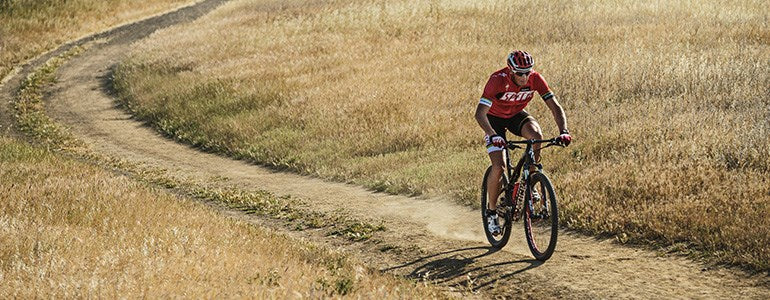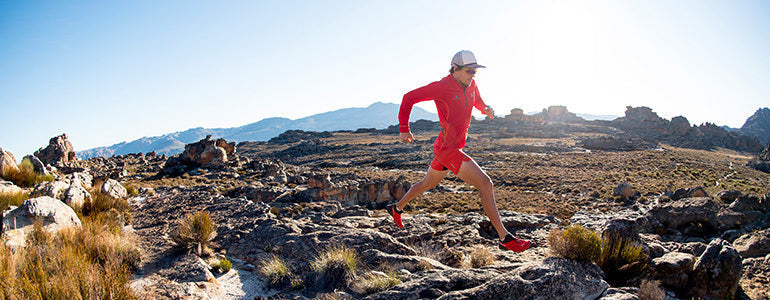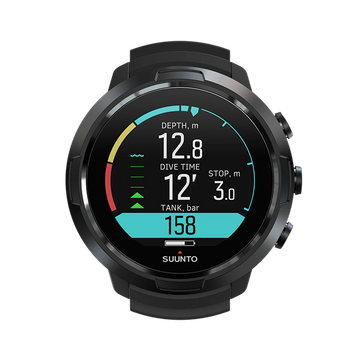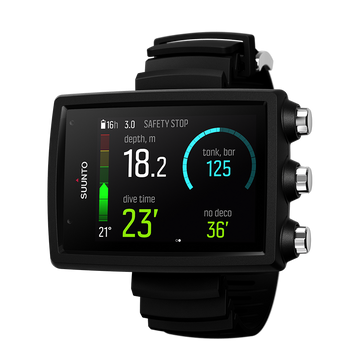

Suunto-blogg

How to plan your training for the year ahead?
When it comes to the art of training endurance athletes, Jason Koop is the man. Koop, as his athletes call him, is Director of Coaching at Carmichael Training Systems and has written a book called Training Essentials for Ultra Running, to be published this coming spring. We caught up with him and got six tips to help you plan your coming training year.
Time travel 12 months ahead
Before sitting down to map out your annual training plan, go for a walk and do this mental exercise: transport yourself forward to December next year and imagine looking back at the preceding 12 months and asking yourself what it is you’d like to see. If you had the best year ever, what would that look like? What adventures or events would make you go, that was awesome! This will help you identify what you’re really passionate about doing, and sometimes it’s not what you think. When you connect with your emotional intelligence, you get much better answers.
Look at the big picture first
It’s not uncommon for people creating an annual training plan to get bogged down in the details. At this time of training cycle, however, you don't need to get down to the nuts and bolts and nitty-gritty just yet. Instead focus on the big picture and worry about the smaller details later. For now, start at race day and work your way back, plotting and planning the major blocks so you stay ahead of the game and avoid having to play catch up. Go from general to specific
Once you've looked at it from a big picture perspective, then you can start to think about moving your training from less to more specific. The longer you are away from the race the less specific and more general your training can be. You can apply this strategy to any kind of endurance race, whether it's a marathon, an ultra marathon or a 20 km trail race. Specificity of training can encompass a lot of different things – the terrain, the intensity of the event, elevation gain. Even the gear that you use – footwear, pack and poles – should become increasingly specific as race day gets closer.
Recruit your support team
Whether it’s your significant other, your family, your running group, or all of the above, getting them invested in the whole process, especially if your goal is really audacious, is crucial. The more people that you have in your corner who understand what you will have to sacrifice and go through, the better for your long-term training process. They can help out with things and offer encouragement. People can't encourage you if they don't know what you're doing.
Proclaim it loudly
If you have something big or crazy planned, stand on a table – or on Facebook – and proclaim it loudly and clearly. You need to do this because it becomes another form of motivation and pressure that will help you achieve your goal.
Track your progress
Tracking your progress with a Suunto watch and sports diaries like Suunto app or Strava will help you compare where you are from one month to the next. Spending some time now working out how your going to track your progress will help in the long run. Ask yourself now what progress indicators are important for you to keep an eye on.

7 off-season tips for triathletes
When it comes to triathlon, there's one man who is supremely qualified to offer coaching – that's the Caveman – and after retiring from professional racing this year Conrad Stoltz is now, he says, "an open book" ready to give away his trade secrets. The four time Xterra World Champion and three time ITU Cross Triathlon World Champion has started his own coaching business, Stoltz Training, and is already being sought after by upcoming athletes. With the off season here, we asked him for some coaching tips on how to use the time wisely.
Don't do too much
After a long, hard season with lots of sacrifices, its very important to recharge physically and especially mentally. Taking time off serious and structured training is crucial for a long and sustainable sporting life. Triathletes tend to be hard driving, over achievers, so getting us to slow down and let go can be tough. But a good, relaxing off season of three to six weeks is key to climbing new heights the following season.
Click for recovery wisdom from the Caveman
© zooom.at/Markus Berger
"Climb a mountain. Paddle a river. Surf. Take the opportunity to have fun and play."
Don't do too little
Don’t let “Ice Cream and Beer Season” get out of hand, as after three weeks, it gets increasingly hard to come back and drop the weight. As one gets older (mid 30s and later) it takes longer to come back from excessive loss of fitness. So stay active by doing other fun sports. Climb a mountain. Paddle a river. Surf. Fatbike along the coast or in the desert. Try a team sport. Take the opportunity to have fun and play. But know your limits – you’re only a triathlete; we’re not used to over eager rugby tackling or direction changes.
Get perspective
After some time spent unwinding and the emotions have settled, one can look into the rearview mirror and learn from the year gone by. What did you do right? Pat yourself on the shoulder and enjoy your hard earned successes. Learn from mistakes. How will you avoid them? Dream about the upcoming year. What makes you tick? Do more of that.
Click for Conrad's transitioning tips
© zooom.at/Markus Berger
Time for change
Be it raising your saddle height, changing shoe brand, implementing weight training, or trying a new diet. The off season is the perfect time for change.
Remember to rehab
Now is the time to rehab unresolved injuries or correct imbalances and weaknesses. Consult with an expert and use the off season to heal the body and mind so you start the season motivated and ready to go.
Enjoy, but in moderation
I once gained a whopping 8kg (18lbs) in the off season, and in hindsight, the fun of putting it on was not worth the hassle of losing it.
Come back slowly
Rookie mistake number one: Start training like a beast the first week! All that built up enthusiasm and energy will make you feel like Superman, but don’t do it! Don’t try to test your fitness or lose that holiday fat in the first week. Forget Strava and take three to four weeks to gently ease into training. You’ll avoid sore legs, injury and frustration. Enjoy a relaxed training vibe, because pretty soon, you’ll get into the sharp end of training for which you’ll need all your mental and physical energy.
MAIN IMAGES: © zooom.at/Markus Berger

THE TRAVERSE ACROSS A MOUNTAIN KINGDOM HAS STARTED
The winners of our #DreamTraverse Video Contest set of on their week long traverse across Lesotho in Southern Africa today.
Grobler Basson and his friends from Cape Town, South Africa, have had the dream of traversing the central part of the Kingdom of Lesotho already for quite some time. Winning Suunto’s #DreamTraverse Video Contest’s 5.000 euro main prize in November gave their project a boost.
Today the team of 18 people started their traverse at Maliba Lodge, which is located in the northern part of Lesotho. The athletes completing the traverse while trail running, mountain biking, kayaking as well as swimming are Raoul Hamman, Hanmarie Stadler, Gustav Roberts, Charl Swart, Quintin van Heerden, Chris de Bruyn, André Joubert, Grobler Basson, Neelke Stadler and Vian Espost. In the documenting, logistics and support roles are Gideo Basson, Josh Rowe, Attie Stadler, Erika Basson, Karmien Joubert, Janine du Bruyn, Inge Basson and Joshua Oostuizen.
The team’s logistics crew is driving an overland truck that carries people, mountain bikes, kayaks and all the rest of the gear, food and filming equipment.
We talked to Grobler Basson just before the start.
How remote are the mountains of Lesotho?“The term ‘remoteness’ in the Lesotho mountains has a slightly different meaning. Even though we may see some herd boys high up in the mountains communication is desperate at best as my knowledge of the native language Sesotho is scary! As Lesotho is a full on third world country, medical assistance would preferably be sought in South Africa which is a 5 to 7 hour drive by car when picked up on a viable road.“
Are you following an existing route or are you taking your own way across the Mountain Kingdom?“The least amount of known routes possible was our outset from the start. However, during the mountain biking legs there will be some jeep track and even a small stretch of tarmac. The remainder of the route is unknown and new, we will be navigating these stages and following some game trails as well as trails made by the local heard-boys. On the first and last trail running stages we will traverse large ridgelines where no paths exist.
How long is the route?“The route is approximately 210km. According to our route schedule, trail running should make up about 70km, mountain biking 110km, kayaking 28km and a couple of kilometres for swimming. However, as we will be navigating in some unknown territory, these figures are seen as mere guidelines!”
The trail running route on the first day will reach an elevation of 3200 meters.
What are the biggest challenges?“As Lesotho has been experiencing some severe drought, water during the long and remote stages becomes a concern. Navigational errors may see some of the athletes prolong their stages significantly. The weather is also a concern. Even though it is summer time, last month while competing in the Salomon Skyrun about 180km from where we will start, it started snowing. Due to the high mountain climate, to under estimate the weather could pose significant danger.”
What will be the highlights of the traverse?“I think this traverse will be filled with some amazing highlights, but when all is said and done and our bodies start to show the miles, to look back and say I experienced this with my closes friends is priceless. It is something that money can’t buy. We truly believe life is better in a team!”
Follow the Kingdom Traverse project also at kingdomtraverse.co.za
Discovering the earth’s last hidden frontiers with Phil Short
Phil Short has been a dive industry professional for over 20 years. He has explored some of the world’s deepest dry caves and spent thousands of hours diving water filled passages. Research and archeology are also his passion, including such assignments as the Antikhytera survey project in Crete. But what is down there that draws Phil to explore these submerged realms?
Cave diving is the last field where human beings are mandatory for exploration. In Victorian times, when somebody climbed a mountain, that was it. They were the first. Now technology has taken over. You can take a look at a picture of a mountain, a valley, jungle, or a gorge before you go there. It has been all mapped.
“When you get to the end of the line in a cave, tie your line to that line and swim around the corner, you're the first human being there. It's true exploration, much like Shackleton, Scott and all of these early explorers did because there was no choice. In cave diving, there's still no choice, and that's why I’m so passionately driven by it. Anyone with a sensible budget can find new territory.”
THE CAVE DIVING ROCK NERD
Millions of years ago, the seas were filled with very different kinds of life forms than today. Over the millennia, soft seafloor turned into limestone, preserving a snapshot of these creatures from the past. Caves cut right through these ancient layers, displaying a rich collection of fossils and telling a geological story of the Earth’s past.
Phil Short has dived caves all over the world, spending thousands of hours diving exploring many kinds of dry and water filled passages. He knows that seemingly small details hide countless stories. Taking a close look, a bulge in the cave ceiling can turn out to be a tooth of an extinct tiger.
“Think about swimming through 100 metres of cave passage today, and memorise all of it. And then get into a time machine and go 3,000 years into the future. The cave would be different because you're diving in something that is alive. The acidic rainwater is dissolving rock, and the flow of the water is eroding it. So the cave is growing. It's forming. It's changing as you're swimming through it.”
SETTING THE PERSONAL LIMITS IN CAVE DIVING
Cave diving requires rigorous training and the right equipment. But there also needs to be the correct mentality and respect for the forces of nature. Constant practise and safety margins are the cave divers tools for keeping the risks at bay.
Phil Short has been a dive industry professional for over 20 years. He has trained hundreds of divers and participated in demanding cave rescue operations. With the experience of thousands of dives, he knows where to draw his line.
“I don't consider cave diving an adrenaline sport. In fact, it's the opposite. Going to an extremely deep point in the ocean, just to get a number for a depth record, that is not my motivation. I would happily do, and have done a lot of very deep dives, for a reason such as a historic shipwreck that nobody's managed to dive. I have more of a kind of Peter Pan, never grow up, child-like approach to exploration. Being there is just magical. It's my drive.”
GUIDING STAR – A YEAR OF UNDERWATER ADVENTURES
“There is something special about the connection between women that cannot be explained with words alone. It is that deep feeling of affinity we have that brings us close and sets a common understanding of what we experience in our life’s triumphs and tribulations. It is a connection only a woman can truly understand. That is what makes the Suunto Jewel so special. The very essence of its existence and what it represents, expresses that unspeakable bond that brings us together,” the Scuba Diver Girls say.
Last February, Suunto sent three Suunto Guiding Star pendants on a journey around the globe. The pendants were passed from one adventure-minded woman to the next, travelling from the Alps to the Arctic Lapland and onwards, and from the Pacific Ocean to icy waters in upstate New York and back under the Caribbean Sun.
We have been following the journey of one pendant in particular, as it was passed on among some of the world’s most inspirational female divers. Here is an account of that journey, told by the divers themselves. While the list of adventures and places the jewel has seen is impressive, what strikes as most extraordinary, is the invisible bond of sisterhood the jewel has created between these women.
The journey took off in the Maldives, where Scuba Diver Girls Margo Sanchez and Stephanie Adamson were the first women to wear the jewel. The jewel spent some memorable moments diving in the crystal blue waters around Maguhdhuvaa Island and later on travelled with Margo and Stephanie back home to San Diego, United States.
“The jewel came with us into our beautiful backyard, an ocean full of kelp, sharks, turtles and a myriad of other amazing sea creatures,” Margo describes. “After a few weeks of enjoying our precious piece of art, it was time to pass it along.”
Scuba Diver Girls chose to give the jewel to Becky Kagan Schott, the Emmy Award winning underwater videographer, photographer and tech dive instructor.
“Becky embodies an amazing spirit that every woman should embrace. We passed our jewel on, holding it tight as to pass on our energy with it. By now it has traveled the world and laid over so many strong women’s hearts. The energy it possesses is most certainly magical,” Margo writes now, looking back to that moment in February.
One of the strong women to hold the Guiding Star next was Jill Heinerth, the underwater photographer and film-maker specialized on demanding cave exploration and 3D imaging. She took the jewel on a National Geographic cave diving expedition in Cuba, where she conducted exploration and survey dives, working with climate scientists and paleontologists:
“My job was to photograph and video our work and also deploy an exciting 3D imaging technology. I was able to take numerous calibrated photographs that were assembled into a 3D model of some of the paleo animal artifacts inside the cave,” she explains. “These files were merged into an accurate model that could be printed in 3D so that scientists could examine and work with a model rather than disturbing the artifact underwater where is remains well preserved and untouched.”
During the months that followed, the Guiding Star traveled onwards to technical diver Renata Rojas, who in turn gave it to scuba diver and submersible pilot Erika Bergman, who handed the jewel to marine biologist, researcher and deep ocean explorer Megan Cook. In August, the jewel landed in the hands of the explorer, teacher and instructor Cristina Zenato, world renowned for her work with shark awareness and conservation. At the time she was in the Bahamas, hosting the Our World Underwater Scholarship Society’s scholar, teaching sustainable shark diving and shark conservation. Her work aims to change the economic situation of the Bahamians, enabling them to move from traditional fishing to different forms of work and income, including professional scuba diving.
During her time with the Guiding Star, Cristina also continued her long term project and conducted cave diving exploration in the area, successfully mapping and connecting previously undiscovered caves and water systems. “It has been a solo expedition and work and the jewel happened to be with me on the day I did the two most important ones. I consider it my luck charm,” Cristina concludes.
Cristina passed the Guiding Star on to technical diver Gemma Smith, the first woman ever to dive at the world famous Antikythera Shipwreck. Gemma took the jewel to Central France, to the Lot/Dordogne region, where she completed her internship and became an Introductory Cave Diving Instructor on Open and Closed Circuit and managed to log some long-awaited cave dives.
“I was also fortunate enough to complete a major cave diving personal ‘bucket list’ goal during the trip. I wore the Suunto Guiding Star to guide me 2.2 kilometers through the earth, reaching depths of up to 80m to finally reach the stunning cathedral-like Bivouac Chamber in the Emergence de Ressel,“ Gemma says.
The journey of the Suunto Guiding Star still continues and we wish every future woman to hold the jewel to get a spark of that energy and courage these women have passed on with the pendant.
“It has been an honor to carry the Star on such big moments in my diving journey, and I really hope I've inspired other women to follow their own diving dreams, and show that size and gender should never hold you back,” Gemma Smith summarizes.
To learn more about the Guiding Star – or to get it for an adventurous woman who inspires you – visit suunto.com

7 signs you’re pushing too hard
Ryan is taking a break from elite racing until 2016. © Craig Kolesky / Red Bull Content Pool
It’s not uncommon for runners to push themselves too hard. That’s why many of us choose to work with a coach – they often stop us from overdoing it. They stress the importance of recovery just as much as training. Without recovery, there’s no improvement.
“If you get overtraining symptoms it’s important to back off,” says Ryan. “The best thing to do, is nothing, watch a whole bunch of movies to allow your body and hormones to recover and settle again.”
No spring in your legs? You might be pushing too hard. © Craig Kolesky / Red Bull Content Pool
1. Beware, the grumpy runner!
When we push too hard with training it’s easy to lose motivation and wind up feeling flat or, worse, irritable. One minute you're feeling great and then the next minute for no reason you are feeling super grumpy.
2. No bounce in your springs
If you find yourself plodding through your training with legs that feel like concrete, it might be a sign you need to ease off. You should have pep in your step. There’s a difference between tired legs and legs with no spring.
3. The force field is down!
Overtraining results in a weakened immune system. With your biological force field out of commission, one virus after another can cruise in and cause illness. If you’re catching one cold after another or just feel lousy generally, then you need to rest.
4. Restless nights
If you are battling to sleep at night and then feel exhausted during the day this might be due to elevated cortisol levels from too much training and stress on your body.
5. The dreaded niggles
Overuse injuries, tendonitis and stress fractures are signs you might need to change down a gear or two. Remember, trying to bulldoze your way through a niggle often leads to full-blown injury.
6. Stuck in the slow lane
When your legs are becoming chronically fatigued, it’s not surprising to find your training times getting slower. Rather than trudging on, it might be time to consider getting those legs massaged and allowing them to recover.
7. Running on empty
Loss of appetite can be another symptom of pushing too hard. This further compacts the problem by starving the body of the nutrients it desperately needs.
Main images: © Craig Kolesky | Red Bull Content Pool































































